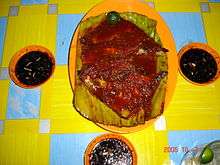Ikan bakar
|
Ikan Gurame Bakar, grilled gourami served with sweet soy sauce | |
| Course | Main course |
|---|---|
| Place of origin | Indonesia and Malaysia |
| Region or state | Southeast Asia |
| Creator | Indonesians and Malay |
| Serving temperature | Hot |
| Main ingredients | Fish, seasoned with garlic, shallots and other spices grilled on charcoal |
|
| |
Ikan bakar is an Indonesian or Malaysian dish of charcoal-grilled fish or other forms of seafood. Ikan bakar literally means "burned fish" in Malay and Indonesian. The barbecued fish is one of the classic Indonesian dish.[1]
As an archipelagic nation, ikan bakar is very popular in Indonesia, commonly found in many places; from an Acehnese beach right down, a restaurant perched over Kupang's harbor in East Nusa Tenggara, to the center of Jakarta's business district.[1] Various specific version exist, including as Sundanese ikan bakar Cianjur,[2] which mainly grilled freshwater fish, such as carp and gourami, and Balinese ikan bakar Jimbaran, freshly grilled seafood fish in warungs clustered near Jimbaran beach and fishmarket in Bali.[3] The barbecued seafood however, is especially popular in eastern Indonesia region; Sulawesi and Maluku where most of the people work as fishermen, and both areas have a vast sea which brings them different kind of seafood.[4] Usually, the fish is marinated with mixture of spices pastes, and sometimes with belacan or kecap manis (sweet soy sauce) and then grilled; sometimes protected with a sheet of banana leaf placed between the seafood and grill to avoid the fish being stuck to the grill and broken to pieces.[4]
Marination and spices
The fish is usually marinated with the mixture of sweet soy sauce and coconut oil or margarine, applied with a brush during grilling. The spices mixture may vary among regions and places, but usually it consists of a combination of ground shallot, garlic, chili pepper, coriander, tamarind juice, candlenut, turmeric, galangal and salt. In Java and most of Indonesia, ikan bakar usually tastes rather sweet because the generous amount of sweet soy sauce either as marination or dipping sauce. It is commonly consumed with steamed rice and the sweet sticky soy sauce poured over finely chopped green chilies and shallots.[1] While the ikan bakar of Minangkabau (Padang), most of Sumatra and also Malay peninsula, usually more spicier and yellow-reddish in color because the generous amount of chili pepper, turmeric and other spices, and the absence of sweet soy sauce.
Ikan bakar is usually served with sambal belacan (chili with shrimp paste) or sambal kecap (sliced chili and shallot in sweet soy sauce) as dipping sauce or condiment and slices of lemon as garnishing. The East Indonesian Manado and Maluku ikan bakar usually uses dabu-dabu or colo-colo condiment.
Variants

There are many variants of ikan bakar, differ from the recipes of marinate spices, dipping sauces or sambals, to the species of fishes being grilled. Almost all kind of fish and seafood can be made into ikan bakar, the most popular are freshwater gourami, patin (pangasius) and ikan mas (carp), to seafood tongkol or cakalang (skipjack tuna), bawal (pomfret), tenggiri (wahoo), kuwe (trevally), baronang (rabbitfish), kerapu (garoupa), kakap merah (red snapper), and pari (stingray). Some of the popular forms of seafood besides fish include sotong (squid), and udang (shrimp).
See also
- Ikan goreng
- Pecel Lele
- List of fish dishes
-
 Food portal
Food portal
References
- 1 2 3 Epicurus (10 November 1999). "Savoring 'ikan bakar' against backdrop of Jakarta at night". The Jakarta Post. Retrieved 27 July 2015.
- ↑ AbraResto (10 November 1999). "Sampling the Best of Indonesia Without Leaving Jakarta". Jakarta Globe. Retrieved 27 July 2015.
- ↑ Brown, Samantha (10 February 2015). "6 dishes every Bali visitor needs to try". CNN Go. Retrieved 27 July 2015.
- 1 2 "Ikan Bakar". Tasty Indonesian Food.com. Tasty Indonesian Food.com. Retrieved 11 August 2013.
